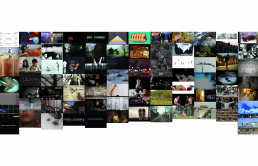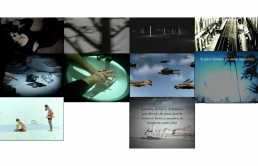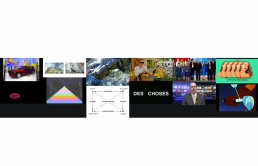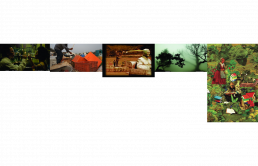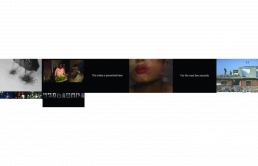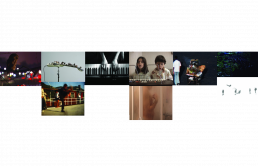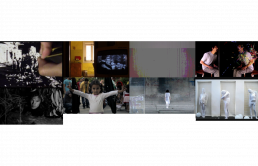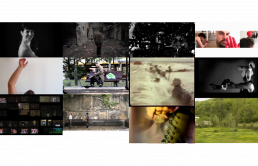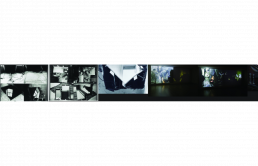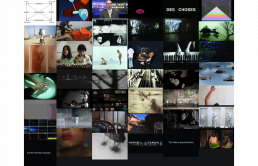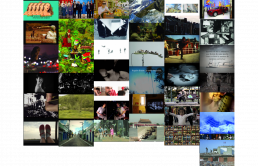“FUSO 2012 – 21 Agosto a 7 Setembro“
Programação
25 Agosto, 22h
Museu Nacional de História Natural e da Ciência
Trânsitos Improváveis
Curadoria de Solange Farkas
Apoio à programação Associação Cultural Videobrasil
Ao compartilharem uma situação geopolítica comum, os artistas selecionados para o programa Trânsitos Improváveis evidenciam uma força criativa única. Mote para práticas e pesquisas que geram formas renovadas de leitura e circulação de arte; o seu vigor transcende o circuito oficial, alimentando diversos campos para a expansão da história e crítica das artes visuais.
Trabalhos que procuram mapear e compreender subjetividades, recriando sentidos para memórias e afetos, dialogam aqui com obras que trabalham sobre problemas da esfera pública ou questionam diversos aspetos da história social, como em ‘Unforgettable Memory’ do artista chinês Liu Wei, ou em ‘Máquinas para viver’ pelo duo americano-polonês Marek Ranis e Jonathan Case. Outras obras, como ‘Round and Round and Consumed by Fire’ da artista boliviana Claudia Joskowicz, transformam a forma como vemos o mundo e sugerem novas visões, evidenciando as experimentações e os riscos na perceção artística.
Originalmente parte das mostras Southern Panoramas, realizadas durante o 17º Festival Internacional de Arte Contemporânea SESC_Videobrasil, estas histórias ganham novos contornos nesta proposta curatorial para o festival FUSO – Anual de Vídeo Arte Internacional de Lisboa. Ao percorrer os quatro eixos da mostra Southern Panoramas – Emotional Mappings, Nature and Culture, Political Landscapes and Optical Devices – este programa revisita as jornadas improváveis dos artistas do vasto sul geopolítico do mundo.
Lara Arellano, Mientras paseo em cisne, 1976/2010, Argentina, 8’25’’
Sentada no banco de trás de um carro percorrendo uma estrada, uma menina pensa sobre o que vê: os seus próprios sapatos vermelhos, as vacas, os lagos distantes que nunca chegam. A conversa entre os pais sentados na frente de carro interrompe os seus pensamentos, aprofundando a sensação de sonolência, sonho e imersão. O trabalho explora o diálogo entre paisagens externas e estados internos, expressão feminina na arte e a ideia da jornada como uma rota emocional.
Chico Dantas, Via República, 1950/2010, Brasil, 6’18’’
A Rua da República sempre foi a principal rota para João Pessoa, a capital do estado de Paraíba, para quem vem do interior. A viagem entre o rio Sanhauá e o Palácio do Governador é tomada por políticos, artistas, intelectuais e trabalhadores. Enquanto percorremos a estrada através das suas lentes subjetivas, o artista narra (em off) as viagens do seu próprio passado familiar, como se quisesse preencher o vazio deixado pelos edifícios abandonados e as memórias da cidade com conteúdo histórico alternativo.
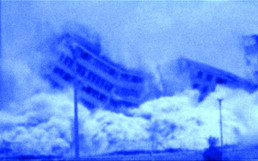
Luis F. Ramirez Celis, Superbloques, 1969/2010, Colômbia/EUA, 5’37’’
O vídeo aborda a demolição do projeto habitacional Pruitt-Igoe em Saint Louis, Missouri (EUA), um antigo ícone em ruínas, considerado o pináculo do modernismo na arquitetura americana. Aqui, o edifício implode ao som de uma canção do cantor venezuelano Simón Díaz, que fala de um morador de Caracas que se recusa a deixar um projeto habitacional que está prestes a ser demolido. A sobreposição irónica de histórias relaciona o fracasso do projeto moderno com a insuficiência de soluções contemporâneas.
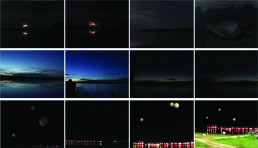
Márcia Vaitsman, Estudo sobre a escuridão, 1973/2009, Brasil/EUA, 12’56’’
Retificar o rio São Francisco como se se tratasse de uma edição de vídeo é alterar não apenas o seu traçado visível, mas o quotidiano das vidas de que dele necessitam para subsistir. Perante um rio cujo curso está prestes a ser desviado, o artista permanece atento à escuridão que o envolve ao cair da noite. No crepúsculo de um percurso, tanto físico como de memórias, o trabalho cria intervenções na paisagem que servem de metáforas para as mudanças do rio e as suas várias fases.

Moran Shavit, Exploring, 1982/2010, Israel/Alemanha, 5’07’’
Este vídeo lida com a correspondência trocada entre o artista e seu pai enquanto o último trabalhava em navios-tanque oceânicos. Quando o pai lê de volta algumas das suas antigas cartas ou o artista comenta essas mensagens a partir de uma dimensão adulta, outras começam a entrar em cena, como o espaço geográfico e subjetivo, a memória objetiva e afetiva. Fotos dos postais que acompanham algumas das cartas ajudam a desenhar este mapa emocional inconclusivo.

Marek Ranis & Jonathan Case, Machines for living, 2010, Polónia/EUA, 4’02’’
Num tom fantástico, este vídeo revisita as ideias utópicas do arquiteto suíço Le Corbusier (1887-1965), um dos mais influentes do século XX. Utilizando materiais que vão desde as suas últimas entrevistas até imagens de elefantes, questiona as interpretações do legado do arquiteto e as nossas formas de morar e coexistir.
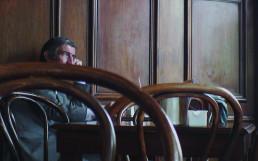
Dan Boord & Luís Valdovino, Tree of forgetting, 2009, Argentina/EUA, 8’52’’
Concebida como um conto curtíssimo, a narrativa transita entre cidades e memórias, como se o tempo fosse um caminho bifurcado de possibilidades que levam sempre a uma mesma eventualidade: o passado. Nesta árvore do esquecimento, um pode desaparecer entre amigos e familiares, e observar como as coisas e lugares do quotidiano assumem as mais diversas formas.
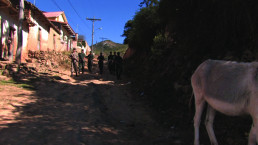
Cláudia Joskowicz, Round and round and consumed by fire, 2009, Bolívia/EUA, 9’12’’
A obra, uma única lenta tomada panorâmica, inspira–se na cena de Butch Cassidy e Sundance Kid, quando a dupla é encurralada pela polícia boliviana. A cena quase inerte cria um efeito de ansiedade, ressalta os vazios da narrativa e reinventa a sua dinâmica.
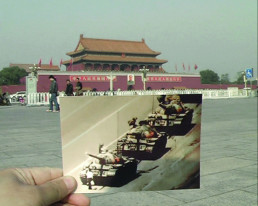
Liu Wei, Unforgettable memory, 2009, China, 10’17’’
Uma tentativa de resgate da memória de 1989, quando chineses foram às ruas em protesto contra o governo de Deng Xiaoping. Numa linguagem direta, que inclui relatos do próprio artista, a obra analisa o poder da memória perante a indiferença.
“FUSO 2012 – August 21 to September 7“
Program
August 25, 10pm
Museu Nacional de História Natural e da Ciência
Improbable Journeys
Curatorship by Solange Farkas
Programming support Associação Cultural Videobrasil
By sharing a common geopolitical situation, the artists selected for Improbable Journeys evidence a unique creative force. Motto for practices and researches that generate renewed forms of art readings and circulation; their vigor transcends the official circuit, nourishing diverse fields for the expansion of the history and critics of the visual arts.
Works that search to map and understand subjectivities, recreating senses for memories and affections, dialogue here with works that deal with dilemmas related to the public sphere or question diverse aspects of the social history, as in ‘Unforgettable Memory’ by Chinese artist Liu Wei, or ‘Machines for living’ by the American-Polish duo Marek Ranis and Jonathan Case. Other works, like ‘Round and Round and Consumed by Fire’ by the Bolivian artist Claudia Joskowicz, transform the way we see the world and insinuate new visions, evidencing experimentation and risk in the artistic perception.
Originally part of the Southern Panoramas’ shows, held during the 17th International Festival of Contemporary Art SESC_Videobrasil, these stories gain new arrangements in this curatorial proposal for FUSO – Anual de Vídeo Arte Internacional de Lisboa. By moving through the four axes of the Southern Panoramas shows – Emotional Mappings, Nature and Culture, Political Landscapes and Optical Devices – this program revisits the improbable journeys of the artists from the world’s vast geopolitical south.
Lara Arellano, Mientras paseo em cisne, 1976/2010, Argentina, 8’25’’
Sitting in the back seat of a car driving along a road, a young girl reflects on what she sees: her own red shoes, cows, distant ponds that never arrive. The conversation between her parents sitting in the front cuts across her reflections, deepening the sensation of sleepiness, dream, and immersion. The work explores the dialogue between outer landscapes and inner states, feminine expression in art, and the idea of the journey as an emotional route.
Chico Dantas, Via República, 1950/2010, Brazil, 6’18’’
Rua da República has always been the main route into João Pessoa, the capital of Paraíba State, for those coming from inland. The journey, between the Sanhauá River and the Governor’s Palace, is taken by politicians, artists, intellectuals, and workers. As we travel the road through his subjective lens, the artist narrates (in off) journeys from his own family past, as if wanting to fill the void left by the abandoned buildings and memories of the city with alternative historical content.

Luis F. Ramirez Celis, Superbloques, 1969/2010, Colombia/USA, 5’37’’
The video addresses the demolition of the Pruitt-Igoe housing project in Saint Louis (USA), a dilapidated former icon, once considered the pinnacle of modernism in American architecture. Here, the building implodes to the sound of a song by the Venezuelan singer Simón Díaz, which tells of a resident of Caracas who refuses to leave a housing project that is about to be torn down. The ironic overlapping of stories relates the failure of the modern project with the insufficiency of contemporary solutions.

Márcia Vaitsman, Estudo sobre a escuridão, 1973/2009, Brazil/USA, 12’56’’
To straighten out the São Francisco River as if editing a video is to alter not only its visible contours, but also the everyday lives of all those whose livelihoods depend on it. Faced with a river whose course is about to be rerouted, the artist remains attentive to the darkness that envelops it at nightfall. At the twilight of a course both physical and made of memories, the work creates interventions in the landscape that serve as metaphors for the changes to the river and its various phases.

Moran Shavit, Exploring, 1982/2010, Israel/Germany, 5’07’’
The video works with the correspondence exchanged between the artist and her father while the latter was away working on ocean tankers. When the father reads back some of his old letters or the artist comments on these messages from an adult perspective, other dimensions begin to come into play, such as geographic and subjective space, and objective and affective memory. Pictures of the postcards that accompanied some of the letters help draw up this inconclusive emotional map.

Marek Ranis & Jonathan Case, Machines for living, 2010, Poland/USA, 4’02’’
With a fantastical touch, this video revisits the utopian ideas of the Swiss architect known as Le Corbusier (1887‐1965), one of the most influential of the 20th century. Drawing from materials as diverse as pictures of elephants and excerpts from one of the architect’s last interviews, the video questions how we interpret Le Corbusier and broader ideas on our ways of dwelling and coexistence.

Dan Boord & Luís Valdovino, Tree of forgetting, 2009, Argentina/USA, 8’52’’
Conceived of as a very short story, the narrative wanders among cities and memories, as if time were a bifurcated path of possibilities that always lead back to the same destination: the past. In this tree of forgetting, one can disappear among friends and family, and watch as everyday things and places assume the most diversified forms.

Cláudia Joskowicz, Round and round and consumed by fire, 2009, Bolívia/USA, 9’12’’
The work was inspired by a scene from the film Butch Cassidy and the Sundance Kid, reproducing in a single, slow panoramic shot the moment in which the American bandits are surrounded by the Bolivian police. The near‐inert scene creates an effect of anxiety that underscores the holes in the narrative and reinvents its dynamics. As in earlier works, Joskowicz addresses the basic elements of classical cinematographic language.

Liu Wei, Unforgettable memory, 2009, China, 10’17’’
The artist tries to recover his memory of 1989, when the Chinese went to the streets to protest against the Deng Xiaoping government. Wei heads out in search of witnesses, carrying with him a camera and a photo of the protests, during which he was almost killed. Using direct language, the work questions the power of memory in the face of indifference.


